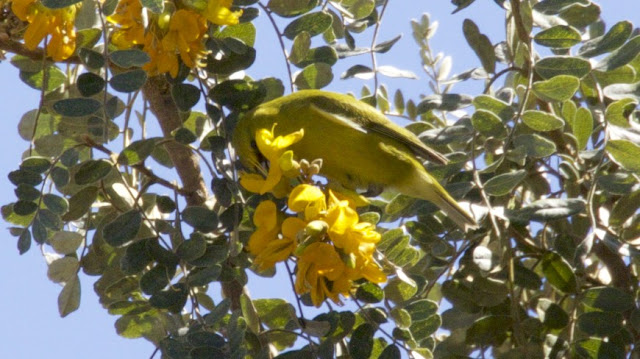Nestled high along the eastern slope of Mauna Kea, Hakalua National Wildlife Refuge (NWR) is home to some of the world's rarest plants and animals. Hakalau NWR was the first refuge ever created specifically for endangered native birds. The refuge is open one day per year to the public and access can be gained with permitted guides.
We were hoping to see the endangered Akepa and Hawaii Creeper, two birds we were unable to find in any of our other birding locations on the island. In addition to the Creeper and Akepa, we also hoped to see the Akiapolaau, Iiwi, Elepaio, Amakihi and Apapane. We were blessed to see all of these special birds. This is the last place on all of the Hawaiian Island to see large concentrations of the stunning Iiwi. To put it into perspective, we typically see 10-15 Iiwi on our favorite birding trail, Pu'u O'o. In Hakalau NWR, we saw over 70 Iiwi in a mile and a half trail.
We had wonderful views of a few of the introduced game birds on our way up Mauna Kea.
Erckel's Francolin in the early morning light.
Male Kalij Pheasant
Female Kalij Pheasant

This Hawaiian Goose or Nene was there to greet us when we arrived at the top of our destination to begin our hike into the rain forest. The Nene is the state bird of Hawaii.
Ohia blooms...a favorite food of nectarivores.
A rare lobelia : one of only two plants of this species left in the wild! It is difficult to see from the photo, but the bloom of the flowers are the exact shape of the Iiwi bill.
As we enter the rain forest the sounds of the birds singing are amazing. The Iiwi and the Apapane are the most dominate singers.
Some of the rarer birds are much quieter and harder to see...
Akepas are cavity nesters requiring old growth trees. As noted earlier, we never saw Akepas in any of our other birding locations. According to our Hakalau guide, the Akepa population in Hakalau has doubled in the past 10 years, a direct result of the refuge providing adequate habitat.
Male Akepa
Male Akepa gleaning insects from Ohia buds.
Female Akepa feeding in Koa blooms

Example of an Akepa cavity
Amakihi

Akiapolauu, a rare honeycreeper filling the niche of the woodpecker
Hawaii Creeper, like its mainland counterpart, feeds on insects & larvae by probing the tree bark
Hawaii Elepaio (Mauna Kea subspecies)
Iiwi feeding on Ohia blossoms. Iiwi numbers are in steep decline on all of the islands due to avian malaria. A single bite from an infected mosquito kills the bird within two weeks. With increasing temperatures due to global warming, mosquitos are making it to higher elevations and as a result taking their toll on the Iiwis. The Big Island just had their warmest summer on record.
Iiwi singing
The forest birds of Hawaii are facing a challenging future due to loss of habitat, disease and climate change. We have our fingers and toes crossed that future generations will be fortunate enough to see and hear these wonderful creatures in the wild.
The World is Full of Beauty & Wonder,
Turtle & Hawk

































